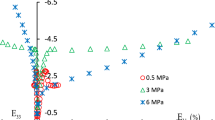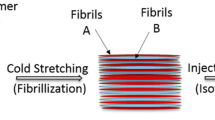Abstract
This article reports an experimental study of the permeability of fibrous porous media based on air flow. Two glass wools have been analyzed in three different flow directions to evaluate their anisotropic structure. The usual flow theories such as Darcy’s law, valid for granular materials, have been shown to apply also to these fibrous media which is a more complex structure (fiber arrangement, high porous media,…). The intrinsic permeabilities and the anisotropic factors have been determined from an air permeability measurement based on a standard test for industrial fabrics. The experimental results have been compared to different models, showing the limits of some simplistic models when applied to our highly porous structures. One model, Kyan’s model based on the flow around submerged objects, was, however, found to agree with our experimental data. This study also demonstrates the interesting use of an experimental technique, which is air permeability measurement (water permeability is not adapted), in the investigation of flow phenomena in a fibrous medium.
Similar content being viewed by others
Abbreviations
- A :
-
Cross-sectional area (m2)
- AF:
-
Anisotropic factor
- A 0 :
-
Specific surface area (m−1)
- D e :
-
Equivalent diameter (m)
- D f :
-
Average fiber diameter (m)
- d h :
-
Hydraulic diameter (m)
- f fk :
-
Kinetic friction factor
- f p :
-
The friction factor
- E :
-
The elastic modulus of the glass fiber
- G :
-
Acceleration due to gravity (9.81 m s−2)
- k :
-
Intrinsic permeability (m2)
- K :
-
Darcian permeability
- k A :
-
Air permeability (m s−1)
- K k :
-
Kozeny constant
- K n :
-
Knudsen number
- k 0 :
-
Shape parameter
- K sat :
-
The conventional saturated
- L :
-
Length (m)
- L t :
-
Length of the straight line (m)
- L e :
-
Effective length (m)
- n :
-
Space between parallel fibers
- N e :
-
Effective pore number
- N d :
-
Fiber deflection number
- N Re :
-
Reynolds number
- q :
-
Volumetric flow rate of fluid (m3 s−1)
- Re f :
-
Reynolds number of the fiber
- R f :
-
Fiber radius (m)
- R v :
-
Hydrodynamic radius (m)
- R L :
-
Laplace radius (m)
- R W :
-
Washburn radius (m)
- S :
-
Solid surface area (m2)
- U D :
-
Filtration or filter velocity (m s−1)
- α :
-
Angle of inclination between two adjacent inclined fibers (\({\circ}\))
- \({\varepsilon}\) :
-
Total porosity
- \({\varepsilon_{\rm e}}\) :
-
Effective porosity
- ρ :
-
Density (kg m−3) of the fluid
- λ air :
-
Mean free path of an air molecule (m)
- μ :
-
Dynamic viscosity (Pa s)
- \({\phi}\) :
-
Solid volume (\({=1-\varepsilon}\))
- τ :
-
Tortuosity
- ΔP :
-
Hydrostatic pressure difference (Pa)
- ΔP flow :
-
Pressure drop due to viscous flow losses (Pa)
- ΔP formdrag :
-
Pressure drop caused by form drag (Pa)
- ΔP deflection :
-
Pressure drop due to deflection of fibers (Pa)
References
Achchaq, F., Beji, H., Gassita, S., Marmoret, L.: Comportement hydrique d’un isolant fibreux, juillet, 8ème congrès de mécanique du 17–20 avril, El Jadida Maroc (2007)
Achchaq F., Djellab K., Beji H., Marmoret L.: Hydric, morphological and thermo-physical characterization of glass wools: from macroscopic to microscopic approach. Constr. Build. Mater. 23, 3214–3219 (2009)
Bear J.: Dynamics of Fluids in Porous Media. Dover, New York (1972)
Bergonnier S., Hild F., Rieunier J.B., Roux S.: Strain heterogeneities and local anisotropy in crimped glass wool. J. Mater. Sci. 40, 5949–5954 (2005)
Carman P.C.: The determination of the specific surface area of powder I. J. Soc. Chem. Ind. 57, 225–234 (1937)
Davies C.N.: The separation of airborne dust and particles. Proc Inst. Mech. Engng. 1, 185 (1952)
Drummond J.E, Tahir M.I: Laminar viscous flow through regular arrays of parallel solid cylinders. Int. J. Multiphase Flow 10, 515–539 (1984)
Dullien F.A.: Porous Media, Fluid Transport and Pore Structure. Academic press, New York (1992)
Happel J.: Viscous flow relative to arrays of cylinders. AIChE J. 5, 174–177 (1959)
Happel J., Brenner H.: Low Reynolds Number Hydrodynamics. Martinus Nijhoff Publishers, Norwell, MA (1986)
Hasimoto H.: On the periodic fundamental solutions of the stokes equations and their applications to viscous flow pas a cubic array of spheres. J. Fluid Mech. 5, 317–328 (1959)
Ingmanson W.L., Andrews B.D., Johnson R.C.: Internal pressure distributions in compressible mats under fluid stress. Tappi 42, 840–849 (1959)
Jackson G.W., James D.F.: The permeability of fibrous porous media. Canad. J. Chem. Eng. 64, 364–374 (1986)
Kaviani M.: Principles of Heat Transfer in Porous Media, 2nd ed. Springer, New York (1995)
Kołodziej J.A: Filtration resistance of a system of parallel cylinders at transverse creeping flow. J. Theor. Appl. Mech. 24, 537–549 (1986)
Kołodziej J.A., Cielak R.D., Konczak Z.: Permeability tensor for heterogeneous porous medium of fibre type. Transp. Porous Media 32, 1–19 (1998)
Koponen A., Kataja M., Timonen J.: Permeability and effective porosity of porous media. Phys. Rev. E 56(3), 3319–3325 (1997)
Kuwabara S.: The force experienced by randomly distributed parallel circular cylinders or spheres in a viscous flow at small Reynolds numbers. J. Phys. Soc. Jpn. 14, 527–532 (1959)
Kyan C.P., Wasan D.T., Kintner R.C.: Flow of single phase fluids through fibrous beds. Ind. Eng. Chem. Fundam. 9, 4 (1970)
Langlais, C., Klarsfeld, S.: Transfert de chaleur à à travers les isolants fibreux en relation avec leur morphologie. Journée d’études du GUT sur le transfert de chaleur dans les isolants fibreux, 6 mars (1985)
Marmoret L., Beji H., Perwuelz A.: Determination of the pore sizes and their influence on the dynamics of imbibition into thermal insulating glass wool. Defect Diffus. Forum (DDF) 312-315, 812–817 (2011)
Mauret E., Renaud M.: Transport phenomena in multi-particle systems. Part I: limits of applicability of capillary model in high voidage beds—application to fixed beds of fibers and fluidized beds of spheres. Chem. Eng. Sci. 52(N 11), 1807–1817 (1997)
Nilsson L., Strenström S.: A study of the permeability of pulp and paper. Int. J. Multiphase Flow 23(1), 131–153 (1997)
Rahli O., Tadrist L., Miscevic M.: Experimental analysis of fibrous porous media permeability. AIChE J. 42, 3547–3549 (1996)
Rahli O., Tadrist L., Miscevic M., Santini R.: Fluid flow through randomly packed monodisperse fibers: the Kozeny–Carman parameter analysis. J. Fluids Eng. 119, 188–192 (1997)
Rodriguez E., Giacomelli F., Vazquez A.: Permeability–porosity relationship in RTM for different fiberglass and natural reinforcements. J. Compos. Mater. 38, 259–268 (2004)
Rumps H., Gupte A.: R Chem. Ing. Tech. 43, 367 (1971)
Sadiq T.A.K., Advani S.G, Parnas R.S: Experimental investigation of transverse flow through aligned cylinders. Int. J. Multiphase Flow 21, 755–774 (1995)
Sangani, A.S, Acrivos, A.: Slow flow through a periodic array of spheres. Int. J. Multiphase Flow 8, 193–206 and 343–360 (1982)
Scheidegger A.: The Physics of Flow Through Porous Media. Macmillan, New York (1957)
Shih C.H, Lee J.: Effect of fiber architecture on permeability in liquid composite molding. Polym. Compos. 19, 629–639 (1998)
Sparrow E.M., Loeffler A.M: Longitudinal laminar flow between cylinders arranged in regular array. AIChE J. 5, 325–330 (1959)
Sullivan R.R.: Specific surface measurements on compact bundles of parallel fibres. J. Appl. Phys. 13, 725–730 (1942)
Westhuizen J.V., Prieur Du Plessis J.: An attempt to quantify fibre bed permeability utilizing the phase average Navier–Stokes equation. Composites Part A 27, 263–269 (1996)
Wu Y.S., Pruess K., Persoff P.: Gas flow in porous media with Klinkenberg’s effect. Transp. Porous media 32, 117–137 (1998)
Xu P., Yu B.: Developing a new form of permeability and Kozeny Carman constant for homogeous porous media by means of fractal geometry. Adv. Water Resour. 31, 4–81 (2008)
Young W.B., Wu S.F.: Permeability measurement of bidirectional woven glass fibres. J. Reinf. Plast. Compos. 21, 755–774 (1995)
Zhong W.H., Currie I.G., James D.F.: Creeping flow through a model fibrous porous medium. Exp. Fluids 40, 119–126 (2006)
Author information
Authors and Affiliations
Corresponding author
Rights and permissions
About this article
Cite this article
Marmoret, L., Lewandowski, M. & Perwuelz, A. An Air Permeability Study of Anisotropic Glass Wool Fibrous Products. Transp Porous Med 93, 79–97 (2012). https://doi.org/10.1007/s11242-012-9945-8
Received:
Accepted:
Published:
Issue Date:
DOI: https://doi.org/10.1007/s11242-012-9945-8




